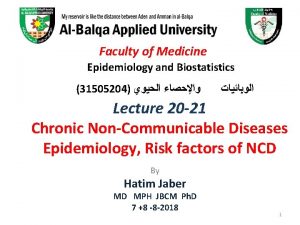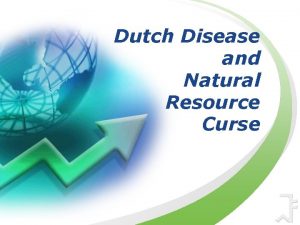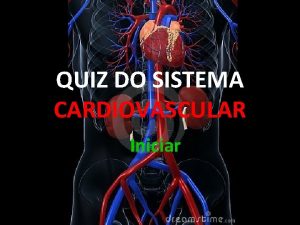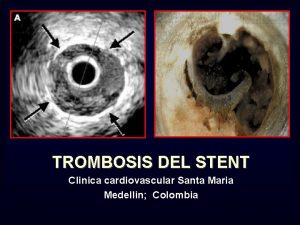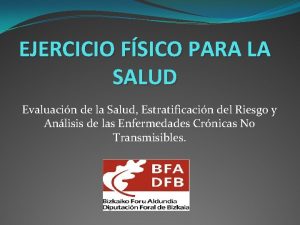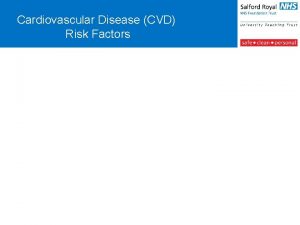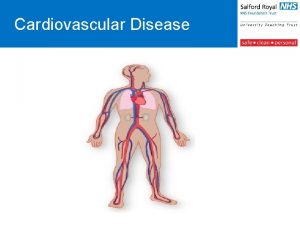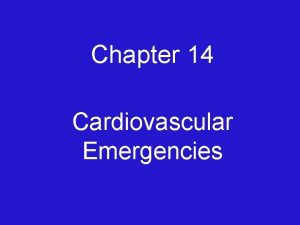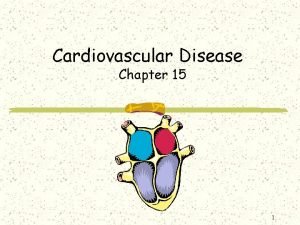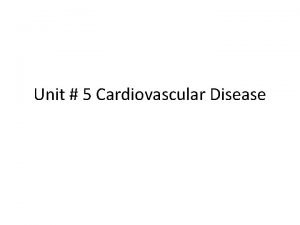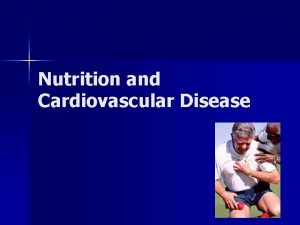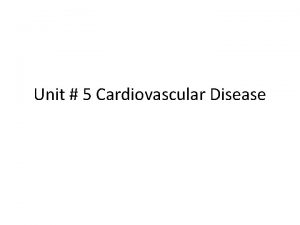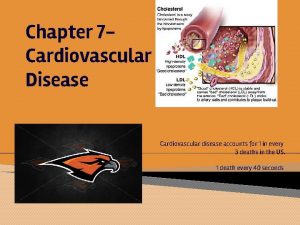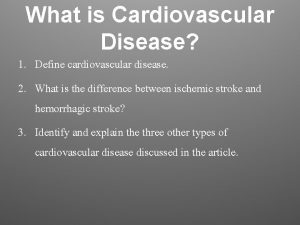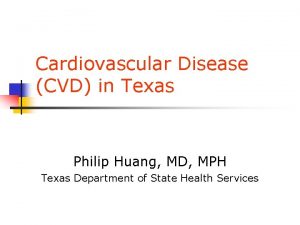Improving Cardiovascular Disease CVD Outcomes A Resource for

















- Slides: 17

Improving Cardiovascular Disease (CVD) Outcomes: A Resource for Primary Care

Welcome Background The resources includes: • Local data tools for exploring your current position with the ambitions for hypertension, atrial fibrillation and cholesterol in comparison to other practices • Guidance and examples of best practice to support improvement in CVD prevention and outcomes in primary care. This resource is for GP Practices to use with the support of their CCGs to improve CVD prevention and outcomes of patients with CVD. This resource was created by CVD prevention leads from national and regional organisations across the East of England. 2 Progress on ICS and STP commitments Slide Contents 3 The Size of the Prize in Cardiovascular Disease Prevention 4 CVD National Ambitions for England 5 What’s happening in your practice? Tools and Resources 10 Hypertension: Improving detection and management 12 AF: Improving detection and management 15 Cholesterol: Improving detection and management


National Ambitions Different organisations have specific ambitions for improving CVD, some of which are detailed in the notes below this slide. Broadly, organisations ambitions are similar: 4 • Optimal management of known patients with atrial fibrillation (AF) • Optimal management of known patients with hypertension • Support to the management of patients with high cholesterol • Increase AF detection • Increase adequate anticoagulation for those with AF • Increase detection of those with high blood pressure • Increase uptake of cholesterol testing and statin treatment for those who need it • Reduce health inequalities. Progress on ICS and STP commitments

How is your practice doing on CVD prevention? Tools and Resources

Cardiovascular Disease Profiles Can be used to view a range of CVD outcomes by practice and compare your practice with others Easy to search and takes you to the information you are interested in Contains a range of tools to aid interpretation e. g. time trends, area comparisons, charts Available via PHE fingertips here Example from Bedfordshire CCG 6 Progress on ICS and STP commitments

Cardiovascular disease primary care intelligence Summarises data comparing your CCG with other similar CCGs, and comparing your practice with other local practices for a range of CVD measures including hypertension, high cholesterol and atrial fibrillation Data has been analysed and comes with accompanying written interpretations for ease of use Pack available for each CCG here Example from Great Yarmouth Pack 7 Progress on ICS and STP commitments

Hypertension: Improving detection and management

Best practice examples - hypertension Intervention Practice Example What was done? Audit and systematic case finding East Berkshire CCG Medicines Optimisation Team Pharmacists conducted a systematic pharmacist led audit in 48 practices. A disease register was created and diagnosis arranged hypertension case finding for the undiagnosed. Diagnosis increased by 12%. Emis. Web or System. One templates Cheshire and Merseyside EMIS-embedded dashboard, audit tool and consultation templates alongside practice based quality protocols, information leaflets and nurse training led to 3 -15% improvement project in performance indicators at 14 weeks. Virtual pharmacist hypertension clinic Lambeth CCG focus on reviewing poorly controlled BP Pharmacists searched for patients with poorly controlled BP and made a management plan in a ‘virtual clinic’ which GPs then implemented over 3 months. There was a significant reduction in BP. Telehealth Florence: telehealth for hypertension A mobile phone app that prompts patients to record monitoring data and share this with clinicians, who can then get in touch quickly if they are deteriorating. Includes protocols for hypertension. Other examples include increased opportunistic testing (e. g. in waiting rooms, clinics), promoting uptake of NHS health checks and home measurement. The NICE Pathway provides an up-to-date summary of guidance and the blood pressure data intelligence pack published by British Heart Foundation gives practical tips on improving care for people with hypertension. . 9

Atrial Fibrillation: Improving Detection & Management

Best practice examples - AF Intervention Practice Example What was done? Toolkit for improving AF detection & management Atrial Fibrillation (AF) Toolkit Online interactive toolkit for professionals and commissioners for improving detection and management of AF. Audit and virtual pharmacist AF clinic Lambeth and Southwark pharmacist led virtual AF clinics Pharmacists identified patients with AF not anticoagulated through an audit and made a management plan in a ‘virtual clinic’ which were implemented by frontline staff. Rate of AF related strokes fell by 25%. This model is now being rolled out by NHS England among 23 CCGs nationally, including NHS Great Yarmouth & Waveney CCG locally. Using new technology to detect AF Podcast Hear how a group of GP Practices in Bedfordshire introduced new technologies into practice to improve AF detection. Other examples include opportunistic pulse checks (e. g. during appointments with >65 s) and encouraging uptake of NHS health checks. The NICE CKS provides an up-to-date summary of guidance. 11

Resources - AF 12 Resources Description NICE AF management decision aids for patients and healthcare professionals NICE has produced a patient decision aid for AF management and endorsed an anticoagulant decision support tool for professionals Cambridge and Peterborough CCG approach – tips for managing AF in GP Describes opportunistic pulse checks, detection monitors, reviewing those on antiplatelets for AF, anticoagulation and falls risk. Stroke Association Stroke Prevention Site FAST test video and resource. GRASP-AF Tool Systematic case finding use GRASP AF to support improvement in management with AF. Available to CCGs free of charge Starting anticoagulation patient video Information for patients supporting the use of novel anticoagulants. NICE guidance on single lead ECG devices for detecting AF Recommendations on single lead ECG devices for detecting AF usingle time-point testing in primary care. NICE Anticoagulation guidance NICE Guidance on anticoagulation in primary care. Primary Care Guidance on initiating anticoagulation Guidance developed by UCL Partners Academic Health Partnership which GPs have found helpful.

High Cholesterol Improving Detection & Management

Increase CVD awareness among patients Participate in national CVD campaigns using Public Health England’s Campaign Resource Centre downloadable tools for GP waiting rooms. Collaborate with community pharmacies with their six campaigns each year. Signpost to behaviour change support with the One You apps including Smokefree, Active 10, Drink Free Days, Couch to 5 k and Easy Meals. NICE patient decision aid on Taking a statin to reduce the risk of heart disease and stroke, intended to help patients make decisions about statin use Best practice example: Medway CCG improved identification of Familial Hypercholesterolaemia (FH) in primary care using clinical decision support software and an audit tool. Case study available here. Useful resources include the NICE Pathway on identifying and supporting people at risk of dying early from cardiovascular disease and the NICE CKS on lipid modification. 14

Engaging patients and staff 15 Technique Resource Patient education British Heart Foundation website has resources on CVD risk factors. Patient Activation Measure (PAM) The PAM tool enables healthcare professionals to understand a patients knowledge, skills and confidence in managing a long term condition. Motivational Interviewing (MI) Training on using MI techniques within NHS Health Checks. NHS Health Check Online Training e. Learning for Health training for professionals on NHS Health Checks Behavioural insights Shorter invitation letters with space for patients to write down their own appointment time increased uptake of NHS health checks from 29% to 33% in a low uptake area. Including the cost of missed appointments in outpatient invitation letters reduced missed appointments by 25%.

Training

Training and support Resource Description BMJ Learning Includes modules on diagnosing and managing AF, starting patients on anticoagulation, blood pressure measurement, managing hypertension in primary care and stroke secondary prevention Presc. QIPP 2 hour online AF training course for primary care professionals (CPD accredited) Heart Education Awareness Resource E-learning on heart diseased, including AF. Produced by the University of Edinburgh. Arrhythmia Alliance Update Meetings In-person update meetings on arrhythmias, including AF NICE Pathways and Resources on hypertension, AF, lipid modification Clinical Knowledge Summaries 17 Another source of support is the British Heart Foundation Health Service Engagement team, described in the image below:
 The cardiovascular system chapter 11
The cardiovascular system chapter 11 Cardiovascular disease risk factor
Cardiovascular disease risk factor Pvd vs cvd
Pvd vs cvd Commvault port 8403
Commvault port 8403 Chemical vapour deposition
Chemical vapour deposition Pvd vs cvd
Pvd vs cvd Pvd
Pvd Communicable disease and non communicable disease
Communicable disease and non communicable disease Resource curse and dutch disease
Resource curse and dutch disease Perbedaan antara resource loading dan resource levelling
Perbedaan antara resource loading dan resource levelling Resource allocation vs resource leveling
Resource allocation vs resource leveling Chapter 5 the cardiovascular system
Chapter 5 the cardiovascular system Sistema cardiovascular quiz
Sistema cardiovascular quiz Clinica cardiovascular santa maria
Clinica cardiovascular santa maria Prairie cardiovascular consultants springfield il
Prairie cardiovascular consultants springfield il Chapter 16 cardiovascular emergencies
Chapter 16 cardiovascular emergencies Cuestionario aha/acsm
Cuestionario aha/acsm Introduction of cardiovascular system
Introduction of cardiovascular system

